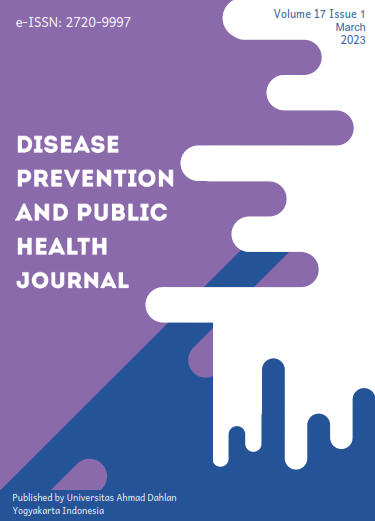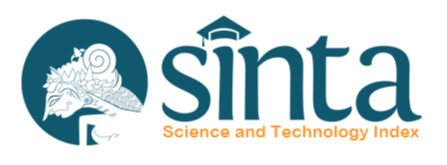The Risk Factors of Physical Activity Behavior in Junior High School Students During the Covid-19 Pandemic
DOI:
https://doi.org/10.12928/dpphj.v17i1.6755Keywords:
Risk Factors; Physical ActivityAbstract
Background: The COVID-19 pandemic has indirectly limited the student’s space and physical activities which increases insufficiency of physically active or sedentary behaviors. Meanwhile, low physical activity is a major risk factor for health problems. This study aimed to determine the physical activity behavior of students in junior high school. Method: This research used a cross-sectional survey; the sample was school children in 34 provinces in Indonesia and was collected through the Physical Activity Questioner Children (PAQ-C) and ASAFA scale. The questionnaire was distributed through Google Forms to 138 junior high school students aged 12-15 years as the age range. A sample size was taken by simple random sampling and 136 valid questionnaires were then analyzed for the relationship between variables by using Kendall's tau test. Results: The results showed that 31.6% of 136 students had insufficient physical activity or sedentary levels, and 14.7% had an active level dominated by female students (13.2%). Based on analysis data, it is found that there is a strong relationship between social support (p= 0.006, r=0.006, r=0.93; 95% CI), nutritional status (p=0.001 r=0.89; 95% CI), and age (p=0.014 r= 0.38; 95% CI) with physical activity. On the other hand, the gender (p=0.091, r=0.27; 95% CI) and school category (p=0.172 r=0.03; 95% CI) do not affect physical activity. Conclusion: The schools should provide students' physical activity guidance in collaboration with parents which can be trained at home to reduce the sedentary behavior among students during the Covid pandemic.
References
Basilaia G, Kvavadze D. Transition to Online Education in Schools during a SARS-CoV-2 Coronavirus [COVID-19] Pandemic in Georgia. Pedagog Res. 2020;5[4]. https://doi.org/10.29333/pr/7937
Zenic N, Taiar R, Gilic B, Blazevic M, Maric D, Pojskic H, et al. Levels and Changes of Physical Activity in Adolescents during the COVID-19 Pandemic: Contextualizing Urban Vs. Rural Living Environment. Appl Sci. 2020;10[11]:1–14. https://doi.org/10.3390/app10113997
Eui-Jae Lee, Dong-II Seo, Seung-Man Lee, Jong-Hyuck Kim. Changes in Physical Fitness among Elementary and Middle School Students in Korea before and after COVID-19. Int J Environ Res Public Health. 2022 Sep 16;19[18]:11712.doi: 10.3390/ijerph191811712
Damian M, Oltean A, Damian C. The Impact of Sedentary Behaviour on Health and the Need for Physical Activity in Children and Adolescents. Revista Romaneasca pentru Educatie Multidimensionala. 2018;10[1]:7183. https://doi.org/10.18662/rrem/19
F P. Physical Activity: Covid-19 Can’t Stop Us. Annals of Physiotherapy Occupational Therapy. 2020;3(4). doi: http://dx.doi.org/10.23880/aphot-16000182
Satija A, Khandpur N, Satija S, Mathur Gaiha S, Prabhakaran D, Reddy KS, et al. Physical Activity Among Adolescents in India: A Qualitative Study of Barriers and Enablers. Heal Educ Behav. 2018;45[6]:926–34. https://doi.org/10.1177/1090198118778332
Elnaggar RK, Alqahtani BA, Mahmoud WS, Elfakharany MS. Physical Activity in Adolescents During the Social Distancing Policies of the COVID-19 Pandemic. Asia-Pacific J Public Heal. 2020;32[8]:491–4. https://doi.org/10.1177/1010539520963564
Jakobsson J, Malm C, Furberg M, Ekelund U, Svensson M. Physical Activity During the Coronavirus [COVID-19] Pandemic: Prevention of a Decline in Metabolic and Immunological Functions. Front Sport Act Living. 2020;2[April]:2018–21. https://doi.org/10.3389/fspor.2020.00057
Qin F, Song Y, Nassis GP, Zhao L, Dong Y, Zhao C, et al. Physical Activity, Screen Time, and Emotional Well-Being during the 2019 Novel Coronavirus Outbreak in China. Int J Environ Res Public Health. 2020;17[14]:1–16. https://doi.org/10.3390/ijerph17145170
Asigbee FM, Whitney SD, Peterson CE. The Link Between Nutrition and Physical Activity in Increasing Academic Achievement. J Sch Health. 2018 Jun;88[6]:407-415. doi: 10.1111/josh.12625.PMID: 29748999.
Ng K, Koski P, Lyyra N, Palomaki S, Mononen K, Blomqvist M, et al. Finnish Late Adolescents’ Physical Activity during COVID-19 Spring 2020 Lockdown. BMC Public Health [Internet]. 2021;21[1]:1–11. doi: https://doi.org/10.1186/s12889-021-12263-w
Moore SA, Faulkner G, Rhodes RE, Brussoni M, Chulak-Bozzer T, Ferguson LJ, et al. Impact of the COVID-19 Virus Outbreak on Movement and Play Behaviours of Canadian Children and Youth: A National Survey. Int J Behav Nutr Phys Act. 2020;17[1]:1–11. https://doi.org/10.21203/rs.3.rs-34730/v1
Report by Indonesia. Trade Policy Review: Indonesia 2020 [Internet]. 2020 Jan 1;221–38. doi: http://dx.doi.org/10.30875/9789287051035c005
Zhao M, Chen S. The Effects of structured Physical Activity Program on Social Interaction and Communication for Children with Autism. Biomed Res Int. 2018 Jan 15;2018:1825046. doi: 10.1155/2018/1825046.
Lapousis G, Researcher I. The Relation between Physical Activity and the use of Internet in Schoolchildren Aged 13-15 Years Old. J Sci. 2017;3 https://doi.org/10.37473/fic/10.3390/ijerph17218107
Grimm L. COVID-19: China and Health Organizations Comment on Novel Coronavirus : January 21, January 23, January 30, and January 31, 2020. Historic Documents of 2020 [Internet]. 2021;45–57. doi: http://dx.doi.org/10.4135/9781071839034.n5
Made Artawan I, Sarim BY, Sagita S, Dedi MAE. Comparison The Effect of Preloading and Coloading with Crystalloid Fluid on the Incidence of Hypotension After Spinal Anesthesia in Cesarean Section. Bali J Anesthesiol. 2020;4[1]:3–7. https://doi.org/10.4103/bjoa.bjoa_17_19
Jabeile H, Kelly As, O'Malley G, Baur. Obesity in Children and Adolescent Epidemiology, Causes, Assessment, and Management. Lancet Diabetes Endocrinol, 2022. May;10[5]:351-365. doi: 10.1016/S2213-8587[22]00047-X.
Karki A, Shrestha A, Subedi N. Prevalence and Associated Factors of Childhood Overweight/Obesity among Primary School Children in Urban Nepal. BMC Public Health. 2019;19[1]:1–12. doi: https://doi.org/10.1186/s12889-019-7406-9
Wulff H, Duan Y, Wagner P. Physical Activity and Social Network Use of Adolescents in Overweight and Obesity Treatment. Int J Environ Res Public Health. 2021 Jun 28;18[13]:6938. doi: 10.3390/ijerph18136938.PMID: 34203513
Asigbee FM, Whitney SD, Peterson CE. The Link between Nutrition and Physical Activity in Increasing Academic Achievement. J Sch Health. 2018 Jun;88[6]:407-415. doi: 10.1111/josh.12625.PMID: 29748999
Thapa K, Bhandari PM, Neupane D, Bhochhibhoya S, Rajbhandari-Thapa J, Pathak RP. Physical Activity and Its Correlates Among Higher Secondary School Students in an Urban District of Nepal. BMC Public Health. 2019;19[1]:1–14. https://doi.org/10.1186/s12889-019-7230-2
Nascente FMN, Jardim TV, Peixoto M do RG, Carneiro C de S, Mendonça KL, Póvoa TIR, et al. Sedentary Lifestyle and Its Associated Factors among Adolescents from Public and Private Schools of a Brazilian State Capital. BMC Public Health. 2018;16[1]:1–8. doi: https://doi.org/10.1186/s12889-016-3836-9
Woods JA, Hutchinson NT, Powers SK, Roberts WO, Gomez-Cabrera MC, Radak Z, et al. The COVID-19 Pandemic and Physical Activity. Sport Med Heal Sci. 2020;2[May]:55–64. Doi: https://doi.org/10.37473/dac/10.3390/ijerph18052235
Sivanesan H, Vanderloo LM, Keown-Stoneman CDG, Parkin PC, Maguire JL, Birken CS. The Association Between Screen Time and Cardiometabolic Risk in Young Children. Int J Behav Nutr Phys Act 2020 171. 2020;17[1]:1–10. Doi: https://doi.org/10.1186/s12966-020-00943-6
Ziaei M, Choobineh A, Abdoli-Eramaki M, Ghaem H. Individual, Physical, And Organizational Risk Factors For Musculoskeletal Disorders Among Municipality Solid Waste Collectors in Shiraz, Iran. Ind Health. 2018;56[4]:308–19. Doi: https://doi.org/10.2486/indhealth.2018-0011
Verjans-Janssen SRB, van de Kolk I, Van Kann DHH, Kremers SPJ, Gerards SMPL. Effectiveness of School-based Physical Activity and Nutrition Intervention with Direct Parental Involvement on Children's BMI and Energy Balace Related Behaviors- A Systematic Review. LoS One. 2018 Sep 27;13[9]:e0204560. doi: 10.1371/journal.pone.0204560.
Gill M, Gloston AMC, Rice LN, Roth SE, Crespi CM, Cole BL, et al. Correlates of Social Support and its Association with Physical Activity Among Young Adolescents. Heal Educ Behav. 2018;45[2]:207–16. Doi: https://doi.org/10.1177/1090198117714826
Eskiler E, Kucukibis HF. Sources of Social Support in Physical Activity Participation: The Moderating Effect of Gender. Int J Psychol Educ Stud. 2019;6[3]:80–8.
Hinkley T, Brown H, Carson V, Teychenne M. Cross Sectional Association of Screen Time and Outdoor Play With Social Skills in Preschool Children. LoS One. 2018 Apr 4;13[4]: e 0193700. doi: 10.1371/journal.pone.0193700.
Downloads
Published
Issue
Section
License
Copyright (c) 2023 Universitas Ahmad Dahlan

This work is licensed under a Creative Commons Attribution-ShareAlike 4.0 International License.
Authors transfer the copyright and grant the Disease Prevention and Public Health Journal right of first publication with the work simultaneously licensed under a Creative Commons Attribution License (CC BY-SA 4.0) that allows others to share (copy and redistribute the material in any medium or format) and adapt (remix, transform, and build upon the material) the work for any purpose, even commercially with an acknowledgement of the work's authorship and initial publication in Disease Prevention and Public Health Journal. Authors are able to enter into separate, additional contractual arrangements for the non-exclusive distribution of the journal's published version of the work (e.g., post it to an institutional repository or publish it in a book), with an acknowledgement of its initial publication in Disease Prevention and Public Health Journal. Authors are permitted and encouraged to post their work online (e.g., in institutional repositories or on their website) prior to and during the submission process, as it can lead to productive exchanges, as well as earlier and greater citation of published work (See The Effect of Open Access).

This work is licensed under a Creative Commons Attribution-ShareAlike 4.0 International License.







